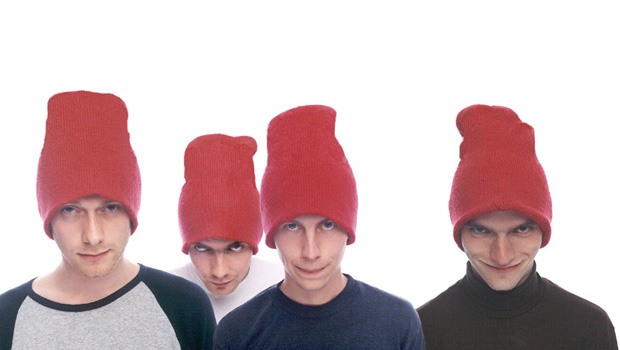

---
It’s hard to accurately summarize Sigur Rós’s music, but I think perhaps singer Jón Þor Birgisson captures it best: “When our first album came out, I played the record to my parents and they got petrified. Then my little sister started to cry. I went into the kitchen to prepare a coffee. My mother followed me and said, ‘Hmmm… Nice record.’” They certainly aren’t everyone’s cup of tea, but I’ll tell you one thing: they make Radiohead fans happier than a clam in a bowl of egg salad.
Sigur Rós hail from Iceland. Only one member, Kjartan Sveinsson, is actually formally trained in music. Birgisson is blind in one eye, gay, and the only vegetarian in the group. Before Sigur Rós, Birgisson was in a band called Bee Spiders (with Sveinsson singing backup) and Stoned. He plays his guitar with a cello bow, and sometimes even holds it up to his face and sings into the pickups to create an eerie, mellow sound. I also hear that they are all fond of Norwegian death metal and definitely do like to make fart jokes.
The original lineup for Sigur Rós, back in the golden days of 1994, was Jón Þor Birgisson, bassist Georg Holm, and drummer Ágúst. (He doesn’t have a last name that I can tell.) In 1997, they released their first album, Von. After Von came Von Brigði, their ‘remix’ album, in 1998. That year, Kjartan Sveinsson, who plays all manner of instruments, joined the fray. In 1999 they released Ágætis Byrjun in Iceland, and slowly everyone began to take notice. Critics everywhere were foaming at the mouth in joy and awe. Pretentious Godspeed You! Black Emperor kids and their less pretentious indie brethren suddenly joined hands, for they were gloriously united through one common factor: Sigur Rós fucking rocks. (After Ágætis Byrjun, the founding drummer Ágúst took leave of the band and the strapping young buck Orri Páll Dýrason replaced him.)
Now Sigur Rós are back and ready to rumble with their fourth album proper, and they’re making it a total hands-on experience. It is titled ( ) for a number of slightly good reasons. The band members justify this latest leap into mystifying pretension by splitting the album in two equal halves, like the two halves of its title. The first side is the lighthearted side; the second is the heavier one. Birgisson has also invented his very own brand-spanking-new language, titled Hopelandic (Vonlenska in Icelandic), in which he sings. He first used this made-up language as the vocals for the title track to their Von album, ‘von’ meaning ‘hope’ in Icelandic.
However, listeners should consider themselves lucky that the album even has a name, since every one of its 8 tracks doesn’t. This is so the listener will give the songs titles based on their experience of them. They were given working titles in the past, when they were first written and incorporated into the 1999 tour set list. Yes, they’ve been around that long – mostly due to the fact that, though Ágætis Byrjun was first released in 1999, it wasn’t officially released in North America until 2001. So Birgisson and Co. have been touring and playing the Ágætis Byrjun and ( ) songs for, like, three years.
Due to this, the band says, it was amazingly difficult to capture the right energy and sound that was needed to make ( ) the groundbreaking masterpiece it was meant to be. This is painfully evident in some of the songs, where Birgisson begins to sound bored, weary, and frankly just half-assed. But he makes up for it tenfold with the heartbreaking passion during the crescendo in Track 7 and the exhilarating Track 8.
However, on some tracks, there is this open-ended question about what might have been, and what actually was. The concept of what Sigur Rós could have possibly achieved seems to be much brighter and greater than what they actually put before us – and my theory is further proved after extensive listening to live renditions of most of the ( ) tracks. Live, these songs are powerful, haunting – but somehow their potency has been drained by the studio recording. Throughout the record the little squeaks and shrills of a synthesizer are evident and they simply extract from its mellow, somewhat melancholic atmosphere, and ruin the pure experience of Birgisson’s amazing, soft falsetto. On the close of Track 4 and Track 7, there is the slightly chilling sensation that Birgisson is right behind you, leaning over your shoulder with his lips to your ear and breathily whispering sweet Hopelandic nothings.
But Track 3 contains no vocals, simply an annoyingly repetitive tinkle of piano keys, which feels incomplete, almost like the song has been born without arms or legs. On Ágætis Byrjun, the song “Staralfur” was achieved flawlessly using the same repetitive piano riff tactic, but that earnest energy – as well as lush sonic padding – don’t exist on ( ).
But I suppose the biggest differences between the new album and the rest of Sigur Rós’s catalog is that its highs and lows are its only elements. And unlike its more accessible predecessor, you can count all the instruments used in each song on one hand.
---
It's still not done. What do I need?